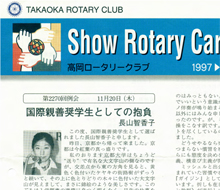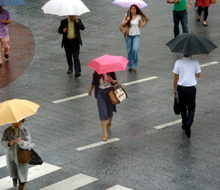
Nikkei Voice June Issue 2009
Constitutional Advocate of Peace: Bridging Nikkei Generations and Beyond through a Transnational ‘Article 9’ Movement
By Chikako Nagayama
The May 15th meeting “Article 9 of Japanese Constitution: Bringing Peace into Today’s World” was the first collective initiative that introduced Toronto audience to the peace clause of Japan’s Constitution: “Aspiring sincerely to an international peace based on justice and order, the Japanese people forever renounce war as a sovereign right of the nation and the threat or use of force as means of settling international disputes…” However, the clause has been under constant pressure for change. The meeting provided Over 70 people attended the meeting at OISE/UT to learn about the historical and current analyses about Japan’s remilitarization.
Joy Kogawa’s opening remarks illustrated a complexity of Japanese Canadian’s position on discussing the forced relocation of Japanese descendants by the Canadian government, on the one hand, and the massacre, rape and biological experiments on Chinese civilians by Japanese imperial army, on the other. Vancouver-born Kogawa recollected that the notions of ‘Japanese’ she learned through her upbringing – love for family, industriousness and humbleness — were denied when she and her family were conceived as ‘Japs’ during the war. The brutality, backwardness and deception of ‘Jap’ race were no longer a fabricated myth when backed up by the actual military violence. Kogawa concluded, “if we lose Article 9, we will lose what is most mature, most humane, decent and hopeful in a world of conflict.”
Subsequently, the 78 minute documentary, Japan’s Peace Constitution (dir. John Junkerman, 2005), presented diverse advocatory arguments. Because the 1946 constitution was composed under the Allied occupation, today’s Japanese nationalists would criticize that Article 9 was merely imposed upon Japan by the General Headquarters. Two draft constitutions were prepared by Japanese research groups and one by GHQ. In the documentary, Beate Sirota Gordon bluntly reveals that the GHQ draft was prepared in a week by researchers like her who were new to the task. While referencing constitutions of Weimer Germany, the Soviet Union and Scandinavian countries, Sirota Gordon was instrumental in implementing the welfare rights of women in Japan, which were not realized in the US constitution. Former American marine and now resident in Okinawa, C. Douglas Lummis maintains that the constitution is an order from the citizens to the government, not an order from above. Historian Rokuro Hidaka advances that the peace constitution is Japan’s apology for Asian people. Whereas filmmaker Ban Zhongyi and feminist activist Shin Heisoo testify that Japan’s military atrocities are vividly remembered and not yet brought into justice, journalists Michel Kilo and Josef Samaha implicate that the expansion of Japan’s Self Defense Force to support US military operations is not only exasperating to neighbouring nations but also to the Middle East.
The peace clause has been pressured to accommodate the de facto military alliance granted by the Treaty of Mutual Cooperation and Security between the United States and Japan. Satoko Norimatsu, the director of the Peace Philosophy Centre based in Vancouver, called audiences’ critical attention to the “New Constitution” draft released by the Liberal Democratic Party in October 2006. LDP proposes to remove the prohibition against the possession of armed forces and the denial of the nation’s right of belligerency from the current constitution. The draft intends to allow Japan’s right to exercise collective self-defense, which means Japan would ‘fight back’ at any country that attacks the US. Norimatsu asserted that this would deprive Article 9 of the suppressing role that has been played so far: “It is true that the government did dispatch the Self Defense Forces to the Indian Ocean […]. But the SDF’s duties were limited to providing logistical support for activities not directly related to the use of force, and within non-combatant areas.”
Following Norimatsu, Yusuke Tanaka vividly recalled one of the peaks of the global peace movement in May 1972 in Tokyo. The key issues were Vietnam War and the reversion of Okinawa to Japan. Tanaka emphasized that the US military base on Okinawa is the largest in Asia and Okinawans continue to be marginalized by Japanese mainlanders: in 2007, the Ministry of Education ordered the modification of history textbooks’ account of the battle of Okinawa at the end of the Asia Pacific war, so that Japanese army’s enforcement of residents’ mass suicide was ambiguated. Met by angry protests by political leaders and activists from Okinawa, the ministry acknowledged that the army was the cause of the mass suicide. “Article 9 should not be treated as national treasure,” stated Tanaka, alluding that the false notion of Japan as a peaceful country could further the neglect of discrimination issues in Japan.
While the influence of US military was repeatedly highlighted throughout the panel, Peter Kuznick offered insights into how people’s patriotic consciousness can be challenged. The Vietnam Veterans Memorial reinforces patriotism by commemorating 58000 deaths of American soldiers while excluding 3.8 million casualties of Vietnamese soldiers and civilians. As professor of Nuclear Studies Institute at American University, Kuznick has taken his students to annual study trips to Hiroshima and Nagasaki in collaboration with University of British Columbia and Ritsumeikan University since 1995. He also complicated the impression of General Douglas McArthur, who tends to be depicted as a savior to Japan. McArthur believed that Atomic bomb was not needed to end the war. However, Kuznick pointed out, he was at the same time responsible for maintaining the Emperor system, and later wanted to use A-bomb to attack China. Although it is commonly said that nuclear weapon was only used twice in history, Kuznick stressed, it is rather like a gun, which allows the control of others without pulling the trigger. Hiroshima survivor Setsuko Thurlow followed to tell that the transition from restrictive, hierarchical imperialist society to post-1945 democracy was liberating, but GHQ did not do justice to A-bomb survivors when they sent doctors only to investigate effects of the bomb but not to rescue the wounded. GHQ censored publications and confiscated personal correspondences on Hiroshima and Nagasaki.
As Norimatsu suggested, Article 9 associations are rapidly growing across Japan and overseas. The movement for preserving and realizing the peace clause now counts over 7000 groups in Japan. Norimatsu and David McIntosh of Toronto Article 9 Event Committee are among the original members of Vancouver Save Article 9 launched in May 2005. From May 4 to 6, 2009, the first international Article 9 conference was held in Japan, attended by over 30,000 from Japan and overseas. Four students were sent with funds raised by Canadian citizens. The May 15th meeting highlighted the unique capacity of urban centres such as Toronto and Vancouver to connect transnational movements and mediate Nikkei generations, given the large size of their communities and active pursuit of exchanges fostered therein.
Chikako Nagayama is completing her Ph.D. at the Department of Sociology and Equity Studies in Education at OISE/UT in summer 2009.
2009 Constitutional Advocate of Peace – English
- Categories →
- English
- エッセイ
-

2014 Summer fish

-

2013 Shall We Dance?

-

2013 Un-sayable

-

1999 カエルの声

-
1998 English is my mother tongue

-

1994 あなたを

-

1997 理由なんていらない

-

1997 抱擁

-

1997 不安海岸

-

1998 鏡のなかの鏡

-

1999 まだ私は

-

1997 国際親善留学生としての豊富

-

2005 中村元道氏インタビュー

-

2005 Nikkei Voice: 「あずみ」・刺客少女のアクションコミック

-

2009 Constitutional Advocate of Peace – 日本語版

-

2008 幻影の故郷(くに)を越えて

-

2009 Constitutional Advocate of Peace – English

-

2004 “Thirst”: Water and the Human Rights Movement

-

1997 請求書

-

1996 アダルトビデオを読む

-
-
